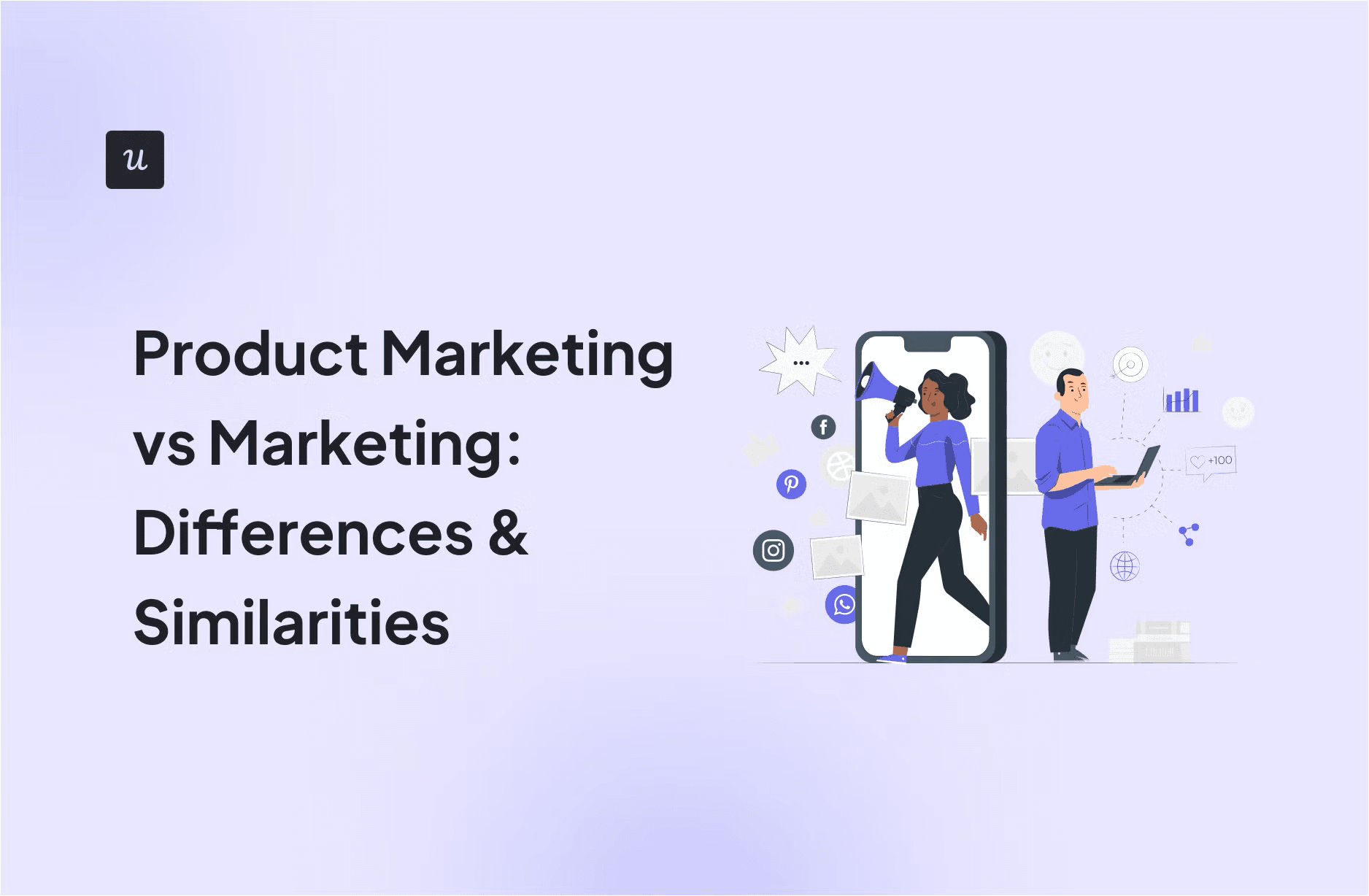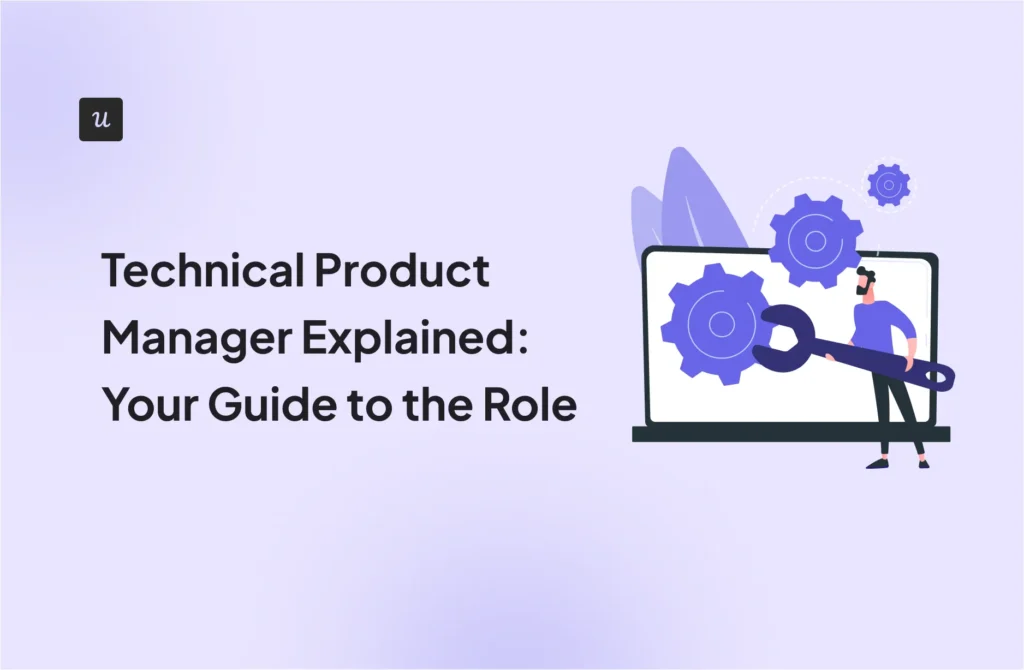
The differences between product marketing vs traditional marketing start with their varying focuses. While marketing drives overall brand awareness and demand, product marketing centers on promoting specific products to boost adoption and retention.
The differences just keep building on from here, extending to their methodologies and the customer journey stages that each one targets.
We know trying to distinguish between the two can get confusing. This article will help, deep-diving into everything product marketing related, such as:
- Differences and similarities in product and traditional marketing.
- Product marketing’s role in marketing.
- A product marketing manager’s responsibilities.
- A product marketing team’s organizational structure.
- Product marketing KPIs and examples.
Try Userpilot Now
See Why 1,000+ Teams Choose Userpilot

What is product marketing?
Product marketing focuses on all the processes involved in bringing a product to market and promoting it to the target market. This includes multiple facets, such as:
- Understanding customer needs.
- Defining product positioning.
- Compelling marketing communications to highlight the product’s unique value.
However, product marketing’s role doesn’t end after the product launch. Instead, product marketers must actively evaluate post-launch performance and continuously gather customer feedback to refine product features.

Differences between product marketing and marketing
In the product marketing vs traditional marketing debate, many key differences emerge. Understanding these differences is crucial for companies looking to optimize brand marketing efforts and effectively reach their target market. Here are a few of them:
Focus:
- Marketing helps with sales enablement, creating demand by putting the word out about your product and acquiring Marketing Qualified Leads (MQLs) for the sales teams.
- Product marketing uses the product as the primary driver for acquisition with a focus on driving product growth across different stages of the funnel/customer journey.
Methodology:
- Traditional marketing strategy promotes brand awareness through ads and campaigns, like email marketing.
- Product marketing encourages potential customers from the target audience to try the product via trials and freemium models.
Customer Journey Stages:
- Marketing primarily targets the top of the funnel (awareness and interest).
- In contrast, a product marketer focuses on all stages, i.e., activation, adoption, retention, and referral.
Let’s understand these differences better using Spotify as an example.
Traditional marketing campaigns for a streaming platform like Spotify will include writing ad copy that clearly states their mission as a music streaming software. They could also create several landing pages comparing themselves to their competitors.
Product marketing efforts, on the other hand, go a step further than these acquisition and awareness strategies. They revolve around driving engagement inside the app and increasing freemium to paid conversion.
Similarities between product marketing and marketing
Product marketing is part of marketing, after all. So, it comes as no surprise that the two share certain similarities as well, such as:
- User research: Traditional and product marketing managers rely on understanding customer needs through comprehensive research. This translates into creating detailed buyer personas, which help tailor strategies to enhance customer acquisition and retention rates.
- Effective targeting: The two emphasize the importance of understanding customer interactions and collecting feedback to accurately target prospective customers, allowing for personalized messaging and positioning.
- Content marketing strategy: Since the two teams typically work closely, their content plans are alike. Both leverage content marketing strategies to engage customers, build emotional connections, and optimize user journeys, ensuring effective marketing communications to convey value.
- Cross-channel promotion: Lastly, both rely on multiple channels to reach the respective target audience, whether through digital, social media, or traditional methods.
Product marketing’s role in marketing
Product marketing is a form of marketing that requires you to keep pushing the product to your target user at each stage of their journey.

The role of the product marketing team in your company will depend on your size and company needs, but these are the common responsibilities:
- Gather and translate the voice of the customer across each stage of the user journey.
- Driving product adoption, retention, and advocacy.
- Defines the product positioning and delivers its value through constant messaging that resonates with the market and end-user persona.
The role of product marketing extends beyond the regular responsibilities of a marketing team to look at the entire funnel and keep driving users to the next stages across the user adoption flywheel.

Main responsibilities of a product marketing manager
Product marketers or product marketing managers perform various roles across the product’s lifespan. These vary from positioning, targeting, and messaging to creating a go-to-market strategy, content writing, and user onboarding. Let’s go over each responsibility in greater detail below.
- Positioning: Product marketers must craft a clear value proposition to present the product effectively to target users and shape customer perceptions.
- Targeting and messaging: Gain in-depth knowledge of user personas, including their pain points and success criteria. This enables product marketing managers to create tailored messages that resonate with users, ensuring effective communication of the product’s value at the right moments.
- Creating the go-to-market strategy: Product marketers must develop a comprehensive plan for launching the product and guiding users through each funnel stage to drive conversion. This details aspects like target users, competitive landscape, and the optimal mix of marketing tactics.
- Driving demand with content writing: The product marketing manager must utilize SEO and content creation to drive awareness and demand. This includes looking after customer success by proactively addressing user questions and integrating the product into relevant content.
- User onboarding with in-app communication: Finally, product marketers must optimize the user’s onboarding experience to improve activation, adoption, retention, and account expansion. This includes using in-app messages to guide users, promote key features, and collect feedback.
Organizational structure of a product marketing team
Every product marketing team is different and structured to fit the company’s needs, size, product type, etc.
Remember that your product marketing team will be driving customer progression across each stage of the user journey.
Because of this, you need to figure out the various skill sets you’ll need to achieve overall success on the budget you have.
A typical product team, however includes these key roles:
- Head of Product Marketing/Product Marketing Manager: Oversees the whole team.
- Growth Product Marketer: Focuses on optimizing in-app experiences using A/B tests, feedback, etc.
- Content Marketing Manager: Structures and plans your content strategy to attract demand and drive prospective customers to signups/free trials.
- Customer Success Manager: Helps both existing and new users with the various friction points they may experience with your product.
- SEO Specialist: Ensures you’re visible to the right users you’ve positioned your product for.
- Chief Marketing Officer: Oversees all your marketing efforts.
Important product marketing KPIs
Product marketers typically cover each stage of the customer journey. So the success of each strategy implemented is measured by tracking several KPIs, at each stage.

These KPIs are indicators of how well or not you’re doing. They include:
- Customer journey KPIs to track: Conversion rates and velocity metrics.
- Acquisition stage KPIs to track: CAC, Free Trial signups, or Demos booked.
- Activation stage KPIs to track: Activation Rate and Average Time to Value.
- Adoption stage KPIs to track: Active User, DAU to MAU ratio, or Feature Adoption Rate.
- Retention stage KPIs to track: Customer Churn, Revenue Churn, LTV, LTV to CAC ratio, or User Retention Rate.
- Revenue (Referral) stage KPIs to track: Net Promoter Score (NPS).
Product marketing examples
Let’s look at how three different brands are using product marketing to increase product growth and boost customer success.
#1 – Talana uses an onboarding checklist to drive engagement
Talana needed a more streamlined onboarding process to train new users better. Their solution was simple – adopting Userpilot to create enhanced onboarding experiences, such as checklists and interactive walkthroughs.
Those two seemingly simple features are key product marketing tools that help reduce time to value. Here’s how:
- Onboarding checklists provide structured guidance, making users aware of the product’s benefits and ensuring they engage with key features.
- Interactive walkthroughs visually demonstrate how to use specific features in real-time, allowing users to quickly grasp the product’s value, leading to faster adoption.
You can also create checklists such that each task triggers a relevant walkthrough, which is what Talana did for some clever product marketing. Explore Talana’s case study in-depth to learn similar insights and takeaways about their journey with Userpilot.

#2 – HubSpot uses highly optimized content marketing to solve their target audience needs
Content marketing is different in a product marketing vs marketing scene. While a typical content marketing strategy will include just blog posts, product content marketing includes much more.
HubSpot, for example, has a ‘Build My Persona’ tool which is an engaging way of solving their customers’ problem of developing clear and comprehensive user personas.

Once you’re done answering the questions, you get a detailed breakdown of your user persona, which they create with the data you provide.
Most product marketers go the route of developing content like this because it’s a quick and more engaging way of getting prospective customers into your product funnel.

#3 – RecruitNow uses in-app onboarding micro surveys to enhance the product experience
Onboarding surveys are great for collecting data from new signups about their roles, industry, or the solution they’re interested in. This data offers valuable customer insights to better inform your product marketing strategy.
That’s exactly what RecruitNow does. It uses Userpilot to design microsurveys for gathering new user data. Then, based on this data, it creates personalized onboarding experiences, introducing users to features and flows that benefit their jobs-to-be-done (JTBD).
To discover more tips for improving onboarding flows, explore RecruitNow’s case study in greater detail.

Product marketing tools and software to have in your stack
To nurture the growth and transition happening at each stage, you need the right product tools to help you engage and keep customers happy while also meeting your team’s needs.
Luckily, a lot of the jobs to be done at each stage of the sales cycle can be automated. This way, your product team can stay focused on customer development and implementing insights found.
Here’s a list of some product marketing jobs that can be automated and the necessary tools to have in your stack:

Looking to automate in-app onboarding and increase product adoption and retention? Get a Userpilot demo and see how you can do it.
- Email automation tools: Active Campaign, Customer.io, Drip.
- Self-serve support: Userpilot, Intercom, Zendesk.
- User communication: HubSpot chatbot, Intercom chatbot, Drift chatbot.
- Social media tools: Kontentino, Buffer, Hootsuite.
- Paid campaign automation: AdRoll, Adzooma, AdExpresso.
Product marketing vs marketing FAQs
Let’s go over some additional insights to finally conclude the product marketing vs conventional marketing debate.
What is the difference between product marketing and other marketing?
Product marketing focuses on promoting and positioning a specific product to drive adoption, customer success, and growth throughout the customer journey. In contrast, other, more traditional marketing encompasses broader brand awareness and lead generation efforts. In short, it targets the overall market presence rather than individual product strategies.
What is the difference between market and product market?
The market generally refers to the overall environment where brands compete, focusing on broad audience needs on a higher company level. Whereas the product market specifically targets individual product features and capabilities. Therefore, a product marketer concentrates on strategies to showcase these benefits to enhance adoption and build user trust.
What is considered product marketing?
Here are a few examples of activities that are considered product marketing:
- Creating marketing campaigns.
- Crafting product messaging.
- Conducting market research.
- Organizing product launches.
- Training sales teams on product features.
- Hosting webinars and product demos.
What’s the difference between product marketing and growth marketing?
Product marketing revolves around managing a product’s positioning and promoting it to target audiences to increase adoption and achieve product-market fit.
Whereas, growth marketing emphasizes more data-driven strategies to drive quick acquisition and conversion at all costs.
In the product marketing vs. growth marketing discussion, the former centers on the product’s value, while the latter prioritizes scalable growth tactics.
Conclusion
You can’t really pick one marketing type over the other since there is no one-size-fits-all marketing hack to improve product adoption and growth.
Instead, focus on what your audience needs from you. Do they need to learn about your brand? Then, stick to traditional marketing. Are they looking for specific solutions or features? Then, it’s time for product marketing. As long as you’re putting your customer front and center, things will run smoothly!
Looking for ways to refine your product marketing strategy? Get a Userpilot Demo and see how you can collect user data and simplify onboarding flows to improve adoption.







